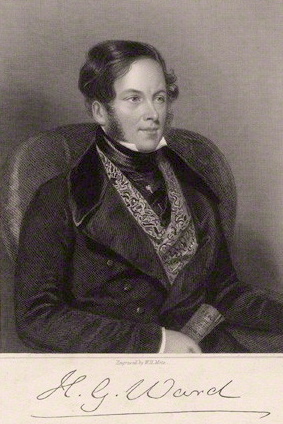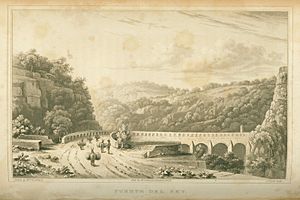Henry George Ward facts for kids
Quick facts for kids
Sir Henry George Ward
|
|
|---|---|

Henry George Ward, 1842 engraving by William Henry Mote, after James Holmes.
|
|
| 11th Governor of British Ceylon | |
| In office 11 May 1855 – 30 June 1860 |
|
| Monarch | Queen Victoria |
| Preceded by | Charles Justin MacCarthy (Acting governor) |
| Succeeded by | Henry Frederick Lockyer (Acting governor) |
| Personal details | |
| Born | 27 February 1797 |
| Died | 2 August 1860 (aged 63) |
| Spouses | Emily Elizabeth Swinburne Ward, m. 8 April 1825 |
| Children | 10 living children, including Dudley Ward (judge) |
Sir Henry George Ward (born February 27, 1797 – died August 2, 1860) was an important English diplomat, politician, and colonial administrator. He served in various roles, helping to manage parts of the British Empire.
Contents
Early Life and Family
Henry George Ward was born in London. His father was Robert Ward. Henry went to Harrow School and then traveled to learn different languages. In 1816, he started working as a diplomat. He was first stationed in Stockholm, Sweden, then in The Hague, Netherlands, and later in Madrid, Spain.
In 1823, he became a special representative to Mexico. He returned to England in 1824 and married Emily Elizabeth Swinburne. Emily was the daughter of Sir John Swinburne. Henry and Emily went back to Mexico in 1825. While there, Emily kept a notebook of sketches from their travels. She even published her own travel writings. They had two daughters in Mexico. Their son, Charles Dudley Robert Ward, was born at sea as they returned to England in 1827. In total, Henry and Emily had ten children.
Henry also helped form a local cavalry unit, the Gilston Troop, in 1831. This unit stayed independent until 1842.
Political Career in Parliament
In December 1832, Henry Ward became a Member of Parliament (MP). He represented St Albans until 1837. After that, he represented Sheffield from 1837 to 1849. He was known as a progressive politician. He believed in classical economics, which focuses on free markets.
Ward often spoke out against the Church of Ireland. He believed it had too much power compared to the number of Protestants in Ireland. This was a big issue in British politics at the time. He also supported the idea of a secret ballot for voting. This was one of the demands of the Chartist movement, which aimed for more rights for working people.
From 1846 to 1849, Ward served as the First Secretary of the Admiralty. This role involved managing the British Navy. He defended the Navy's spending in Parliament.
Journalism and Colonies
Henry Ward also bought a newspaper called the Weekly Chronicle. He used it to share his political ideas and campaigns.
He was a strong supporter of Edward Gibbon Wakefield's ideas about colonisation. This system aimed to create new colonies by selling land and using the money to help people move there. Ward was part of the South Australian Association in 1834. He also chaired a committee in 1836 that looked into how land was sold in British colonies. This committee supported Wakefield's system.
Ward was also involved with the New Zealand Association in 1837. He tried to get Parliament to support more colonisation efforts. However, these plans faced opposition and did not always succeed.
During the early days of railways, Ward was very involved. He spoke in Parliament about people who tried to make quick, dishonest profits from railway shares. He himself faced financial difficulties during the "Railway Mania" of 1846.
Colonial Administrator Roles
In May 1849, Ward was appointed Lord High Commissioner to the Ionian Islands. These islands were under British protection. When he arrived, he found the local government difficult to work with. He had to deal with a rebellion in Cephalonia. He worked to restore order there. He also used his powers to ban newspapers and remove members of the assembly who caused trouble. He left the Ionian Islands in April 1855.
On May 11, 1855, Ward became the Governor of Ceylon. He focused on improving the country's infrastructure. He worked on building railways, improving communication, and managing immigrant workers. He also made the public administration stronger. When the Indian rebellion of 1857 broke out, he sent British troops from Ceylon to help in Bengal.
Later Life and Death
In June 1860, Ward became the Governor of Madras (now Chennai) in India. However, he served only for a few weeks. He sadly died from cholera on August 2, 1860, at the age of 63. He was buried in St. Mary's Church in Madras.
Henry Ward was given the honor of G.C.M.G. (Knight Grand Cross of the Order of St Michael and St George) in 1849. A statue was built in his honor in Kandy, Sri Lanka.
Works and Legacy
Henry Ward wrote two books about Mexico. His wife, Emily, created the illustrations for these books. In his book Mexico in 1827 (published in 1828), he shared his balanced views on Mexico's future. He also wrote about the country's mines.
He also wrote a book called The First Step to a Poor Law for Ireland in 1837. In this book, he suggested that large-scale emigration, supported by the government, was needed before a system like the workhouse could be introduced in Ireland.
A collection of his speeches and notes from his time in Ceylon was published in 1864.
Family Life
Henry Ward married Emily Elizabeth Swinburne in 1824. Their oldest son, Dudley Ward, became a judge in New Zealand. Their second son, Swinburne Ward, became a diplomat and was also interested in nature.


